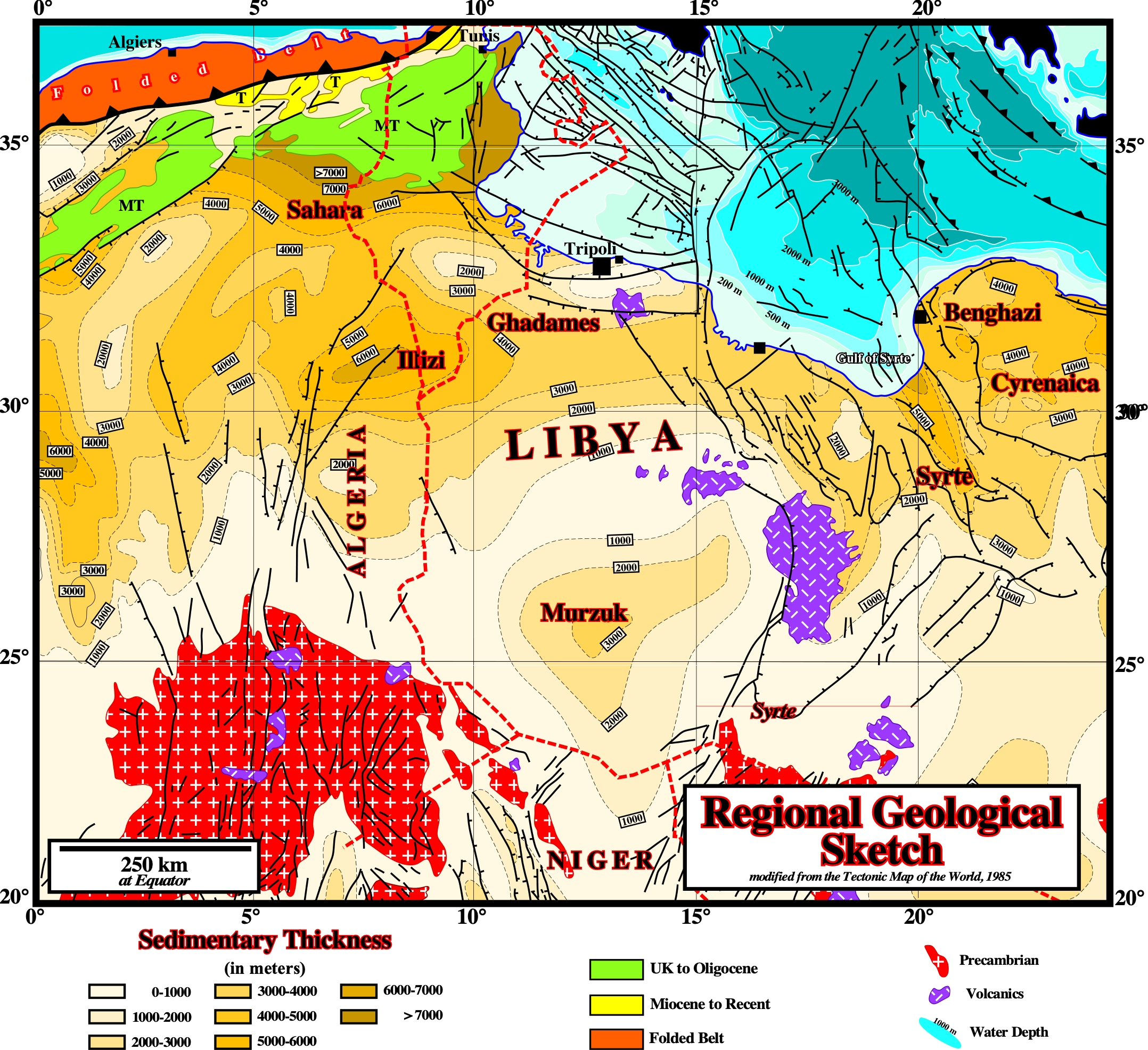.jpg)
.jpg)
Libya Offshore
Gulf of Syrte

On this regional geological map we can see the main geological features characterizing the Syrte embayment (onshore) and the Marmarica / Djefara geographic basin (onshore). The Syrte embayment or Syrte geographic basin, is the youngest of the Libyan geographic basins (Murzuk, Ghadames, Al Kufra and Cyrenaica). It has the largest petroleum reserves in Libya and is ranked 13th among the world's petroleum sedimentary basins. Geologically speaking, certain geoscientist consider that the area was a permanent high from the Middle Paleozoic until the Early Mesozoic and they attribute its origin the collapse of the Syrte Arch during latest Jurassic to Early Cretaceous times. In the Bally's basin classification it corresponds to an Atlantic-type divergent margin. The Marmarica / Djefara geographic basin covers almost Libyan offshore, between Tunisia/Malta/Ragusa platform and Cyrenaica geographic basin. The Libya offshore seismic lines suggest two phase of rifting. The half-graben and graben of the first phase were filled, mainly, by non-marine Jurassic– Early Cretaceous sediments, in which organic rich lacustrine sediments can form a significant generating petroleum subsystem. The second phase, which is less evident than the first one, since there is a change in the orientation of the σ2 of the extensional tectonic regime responsible of the lengthening, occurred during the Mid-Late Cretaceous. During this phase there are development of troughs and platforms. A marine ingression, progressively, filled the lower areas with clastic sediments, which are fossilized by evaporites and and shallow-marine carbonates. The Atlantic-type divergent margin seems to be initiated by the Maastrichtian marine ingression, since marine sediments covered not only the infilled troughs, but the rifted platforms as well (rift-type basins). At the end of the Miocene, during the Messinian a thick salt interval was deposited following a drying-up of the Mediterranean Sea between 5.96 and 5.33 Ma. The dessication of the Mediterranean Sea ended with the reopening of the Strait of Gibraltar (Zanclean marine ingression). It is interesting to notice that only the inflow of Atlantic water maintains the present Mediterranean level. In fact, without the Atlantic water's inflow, with a rate of net evaporative loss of ± 3,3 km3/y, the Mediterranean Sea, with its 3.7 Mkm3 of water, would dry up ± 1000 years.
A.jpg)
.jpg)
Using the original seismic line from which this Canvas autotrace was done, several geoscientists consider two rifting phases before the definitive breakdown of the Gondwana extended lithosphere. Extensional Jurassic-Early Cretaceous depocenters trending, approximately, E-W characterize the initial rifting phase. The second rifting phase, which seems to start during the Albian-Early Cenomanian continued till near the Maastrichtian. This late rifting phase is characterized by extensional structures, bounded by normal faults striking NNW-SSE. The Atlantic-type divergent margin, seems to started during Late Cretaceous when the low structural areas (troughs) were filled by evaporites and organic rich sediments deposited during the initial (restricted) marine ingression, following by the breakup of the lithosphere. Later, the high structural areas, between the troughs, were flooded and buried, mainly, by carbonates. In fact, by the Maastrichtian (maximum marine ingression), marine sediments fossilized the majority of the high structural areas, i.e., the less subsiding areas, created during the rifting. During the Cenozoic, extensive carbonate banks and shoals built out over the less subsiding areas developed during Late Cretaceous rifting. Intermittent episodes of regional eastward tilting, associated with Alpine orogeny, took place during the deposition of the late post-Pangea continental encroachment stratigraphic sub-cycles.
Send E-mails to carlos.cramez@bluewin.ch with comments and suggestions to improve this atlas.
Copyright © 2001 CCramez
Last update:
2022